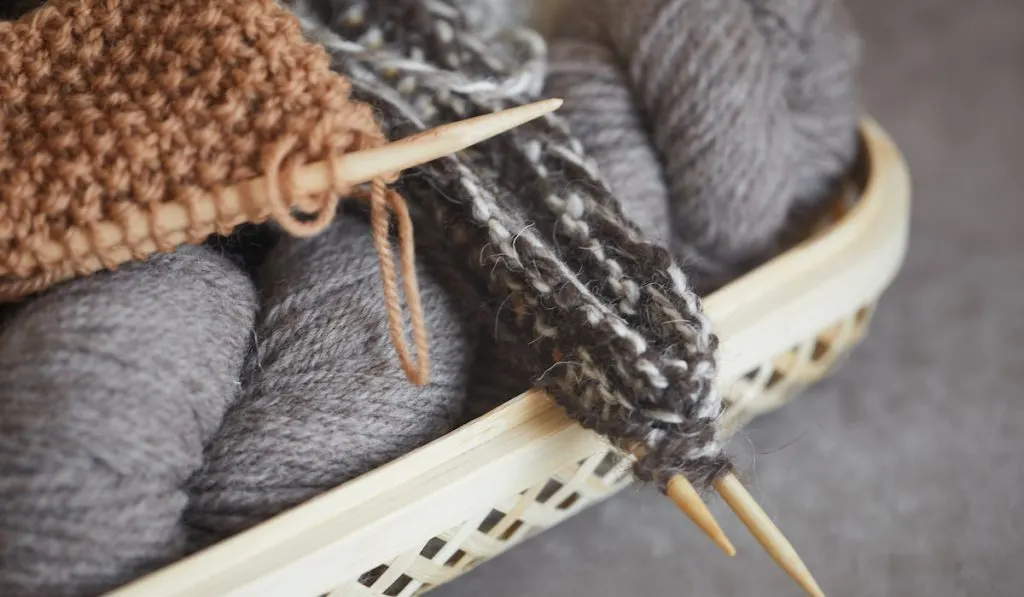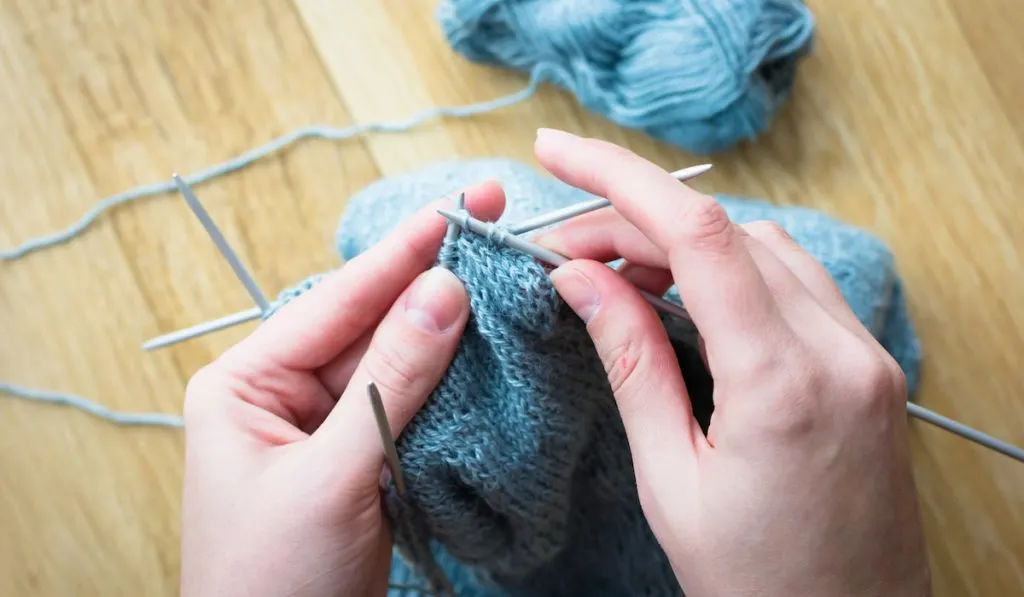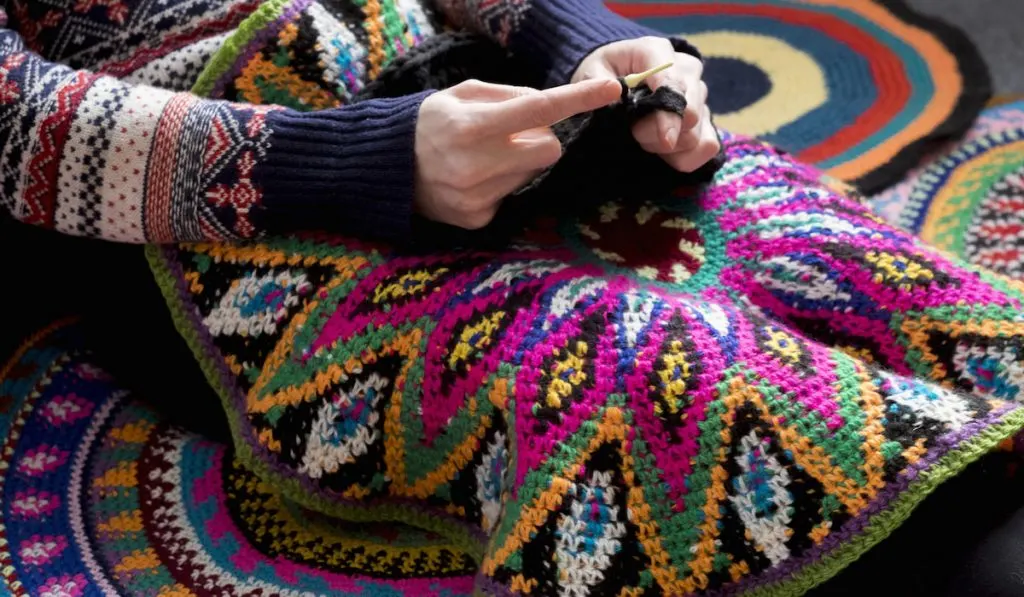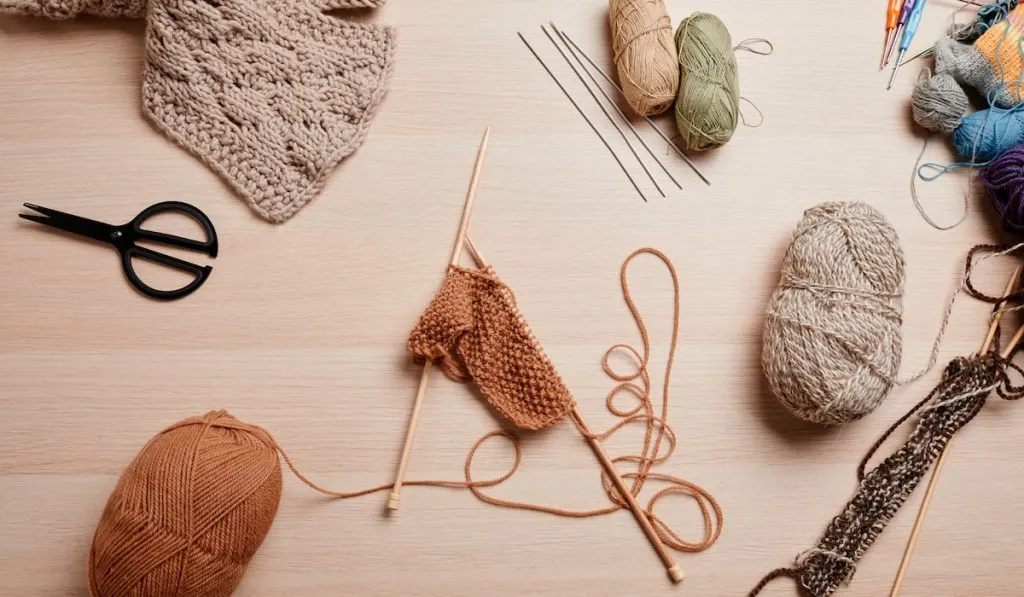Maybe you’ve just broken your hook right before finishing a crocheting project and all you have available is your knitting needles.
Maybe you’re working on a knitting project and you see certain parts that you think can only be accomplished with crochet or would look better crocheted.
You could be trying to challenge yourself, doing two types of fiber weaving in one project. But are crocheting and knitting techniques even similar enough to combine?
Can you mix crocheting and knitting?
Yes, you can. But of course, you want more information than that. There’s probably a “how” popping up in your mind right now, right? Well, read on to discover how you can mix crochet and knitting.

What Is the Difference Between Crocheting and Knitting Anyway?
First, before we get to ways you can combine the practices, let’s dive deeper into their similarities but also their differences. Knitting and crocheting are both methods of manipulating fibers, most commonly yarn, and weaving them into other objects such as blankets or scarves.
Knitting and crocheting both use the same type of yarn, which is essential in their ability to be used together on the same project.
Doing similar projects, both will use approximately the same length of yarn. The only exception to this would be crochet yarn, which, obviously, lends itself to crochet because the thinner yarn works better with a hook and not needles.
Knitting versus Crocheting: Instruments Used for Both Techniques
Knitting is accomplished with two pointed sticks called knitting needles that come in either metal, plastic, or wood. It can be done by hand, but also by loom or machine. Knitting looms make the process faster, and knitting machines bring the pace up to mass production level.
Crocheting is done with a crochet hook, which is a single stick with a hooked end. These hooks can be all different sizes, depending on the project and how small or large you’d like the holes to be. They can be made from materials such as metal, wood, plastic, bamboo, or aluminum.
Crocheting can only be done by hand– there are no looms or crocheting machines, showing how intricate of a process it is! Crocheting is also typically the more dainty and delicate process, creating more fine designs.

Crochet vs. Knitting: What the Stitches Look Like
The main difference between crocheting stitches and knitting stitches is the shape and structure of them. With crocheting, there is only one loop of yarn that is active at a time, which keeps your entire project from unraveling. Because of this, crochet is much easier to keep together and less likely to fall apart than knitting projects.
Knitting projects need multiple yarn loops across the needles. The whole row is dependent on the previous stitch, so “dropping” one stitch could lead to unraveling and the downfall of your project. Crocheting will not unravel if one stitch is dropped, so that is one perk between the two.
Knitting vs. Crocheting: The Outcomes
Knitting’s technique allows for more flexibility in the fabric, which is why clothes are usually knitted and not crocheted. If you want to make a more draped object, then knitting is the way to go. If you want your project to stand up on its own, you may want to crochet instead.
If you want a more sturdy object that will hold itself up or support something else, like a coaster or a stuffed animal, crochet is the right tool to use.
Of course, going back to the topic of this article, perhaps there are some parts of your object you’d like to be tight, and some parts to be more flexible, and that’s where mixing practices comes in handy.

Warning: Proceed in Mixing Processes With Caution
Typically, people don’t mix knitting and crochet. The two make different types of fabrics, as I said above with knitting creating limper fabrics and crochet tighter ones. This may cause some wackiness with the overall look and texture of your project.
Because of the stitching structure, crochet and knit look different: crochet leaning on the bulkier side. Stitch gauges, as well, are dissimilar between the two techniques so you’ll have to find a way to convert it into a working process between the two. However, when done right, combining the two can create some very unique and well-engineered products.
Don’t attempt this mashup if you’re new to crochet or new to knitting: it will probably confuse you. I recommend doing it only if you are experienced with both and have an idea for how you want your project to look, structurally or visually, with mixing the two practices. Or, if you’re looking for a challenge!
Alright, warning’s over, if that didn’t scare you away, carry on reading.
Ideas of How to Combine Knitting and Crocheting Into One Project
You can choose to use one method over the other for a variety of reasons: as I said above, you may want some parts of your project to be flexible and some stiff. You may like the way knitting looks for one part of your project, and the way crochet looks for the other.
Or, one method may be easier depending on what you’re doing! You can totally switch between based on ease, that’s such a boss move, not gonna lie.
Knitting Plus Crocheting: Adding an Edge to Your Project
One great example of this is hot pads for taking food out of the oven or placing hot things on so it doesn’t burn the table. You want it to be flexible, so you chose knitting for the middle, plus it looks really pretty doing stripes in different colors.
However, you want the whole edges to be one solid color, and you want them to look professional and uniform and not unravel. So, you switch to crochet!
Crochet on the edges of these hot pads will make a thick and elegant finish off to your project. You can take each pair of knitting loops on the ends and make one crochet loop sealing them together, making it much harder for the project to unravel which would be quite a shame because one, you spent so long on it, and two, your table– or more pressingly, your hands– will burn!

Crocheting Plus Knitting: Circling Around Difficulty
Trying to knit a circle rarely works. They are complicated and frustrating and usually end up not looking like a circle anyway.
So, if you want to knit something, like a mug cozy for keeping your hands warm but not burnt from your beverage, you can make the initial circle for the bottom with crochet. Then, once that’s over, you can knit all the way up to the top and finish the project.
Except for a few little maintenance things: remember how crocheting is more secure than knitting? And crochet makes more firm shapes and objects? So, for your mug cozy, make the part that goes around the handle crocheted.
This will hold a more definite shape, which will help with the overall professionalism of the product, and keep this hole in the shape from unraveling. Finally, the button seal at the top of the mug should also be crocheted on, so it doesn’t unravel and cause you to lose the button.
Mixing Knit and Crochet: A Warning About Size
When you are mixing the two practices, make sure you’re being smart about size! Using a big hook and small needles, or vice versa will make wonky stitches and gaps in your project.
Make sure the two methods are matching the sizes of the hook and needles to as close of a match as possible. Lay them side by side, research conversion between the two, or ask an employee at the craft store which ones work best together.

The Bottom Line
Regardless of your purpose in wanting to mix crochet and knitting– whether you’re just curious, it’s your last resort, or you have some pretty cool project ideas circling around the combination of these different structural and appearances between the two practices, the answer remains: yes, combining these two methods of fiber stitchery is possible.
There are stubborn differences that must be addressed: Knitting uses needles, while crochet uses a hook; knitting is more loose and flexible, and crochet is more tight and stiff; and knitting makes thinner patterns, while crochet is much bulkier; but overall, these differences are only an issue if you are new or would like your project to be seamlessly uniform.
There are textures and structural tactics that can go into combining knitting and crochet, ranging from wacky to creative, to masterful. And to whichever of these you are leaning towards, have faith in your abilities and I wish you the best of luck!
Resources
- https://www.worldinaspin.com/articles/mixing-knit-and-crochet
- https://www.thesprucecrafts.com/differences-between-knitting-and-crochet-4077447
- https://gannetdesigns.com/2017/05/22/a-different-way-to-combine-knitting-and-crochet/
- https://www.adknits.com/blogs/news/how-to-combine-knitting-and-crochet-in-the-same-project
